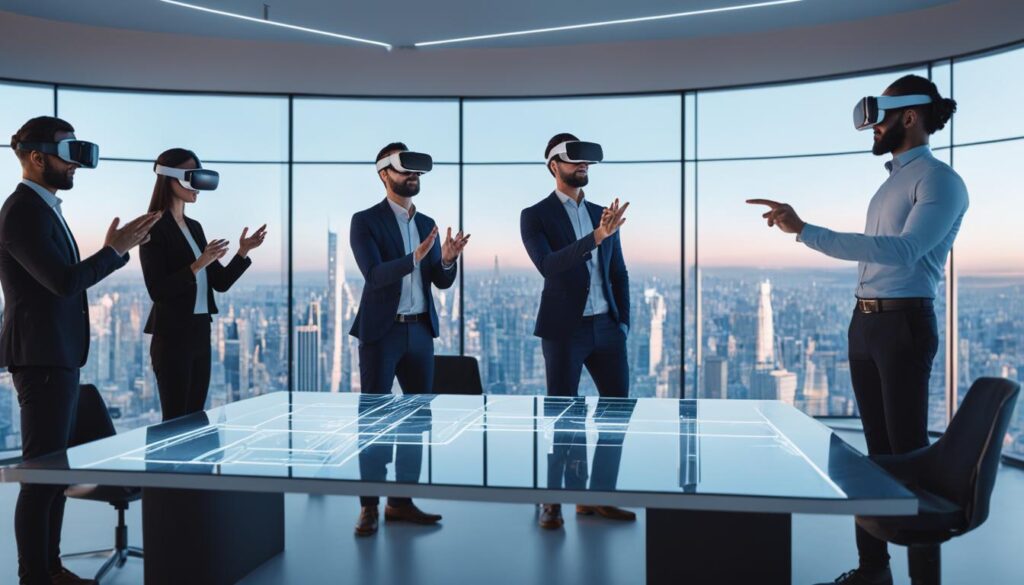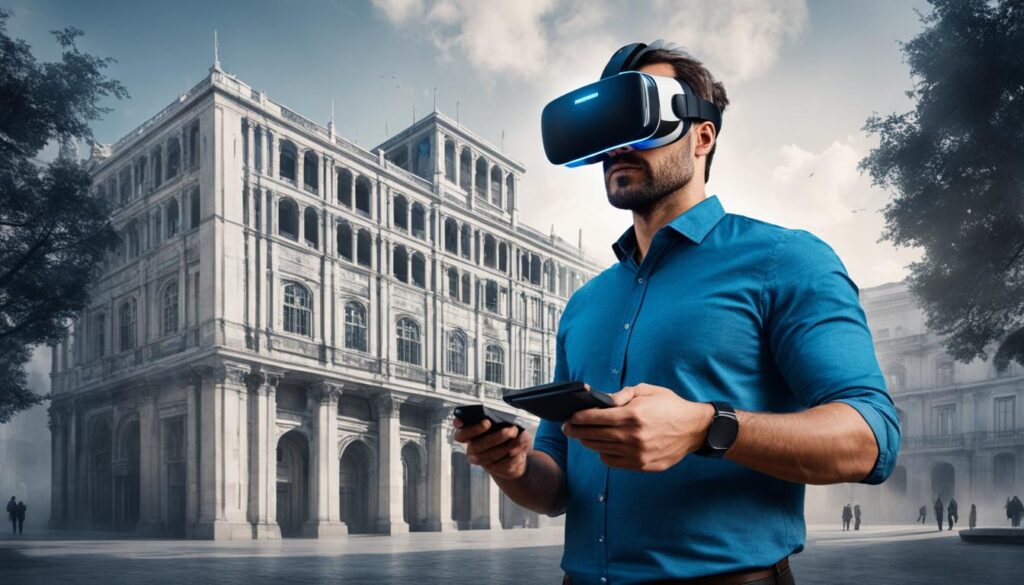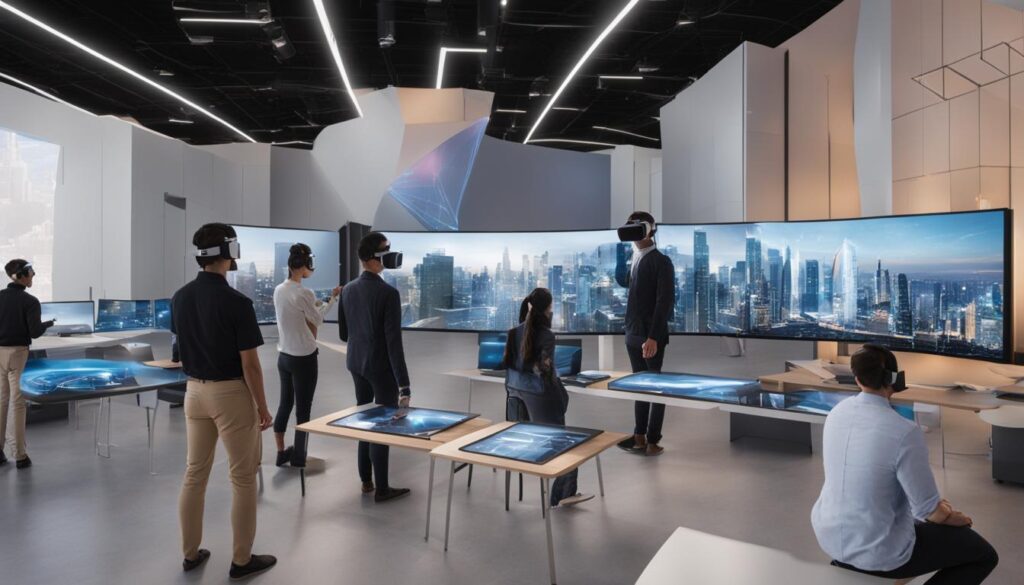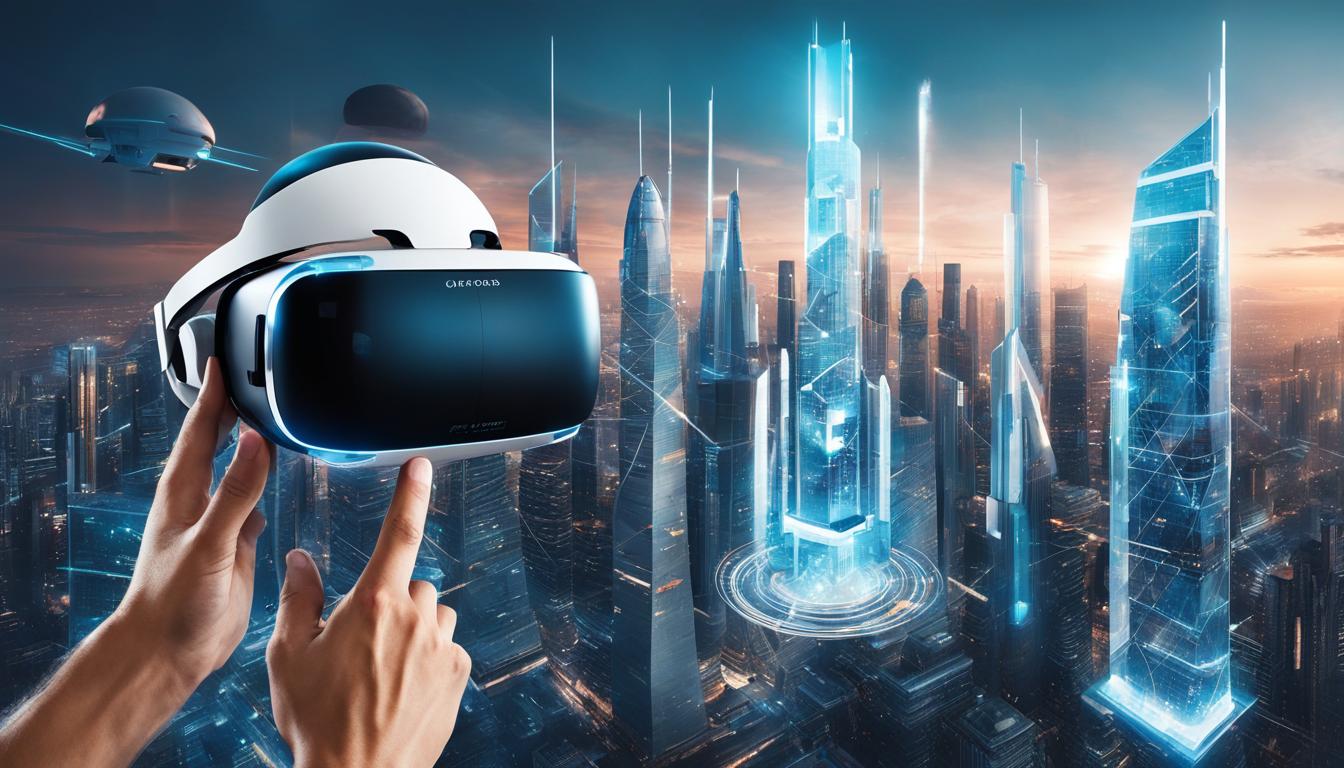The integration of virtual reality (VR) and augmented reality (AR) technologies into the field of architecture is revolutionizing the industry. Architects are now able to use these immersive technologies to enhance the design process, collaborate with clients and stakeholders, and visualize projects before they are built. VR and AR are not only making architecture more efficient but also transforming the way architects work and present their ideas.
Virtual reality in architecture allows architects to create lifelike, three-dimensional environments that clients can explore and experience. By putting on a VR headset, clients can get a sense of scale, space, and atmosphere in a way that traditional 2D drawings or computer renderings cannot replicate.
Augmented reality in architecture enhances the real world with virtual elements. Architects can use AR applications to overlay digital models onto physical spaces, allowing clients to see how proposed designs would fit into their existing environments. This technology provides a unique way to visualize and communicate design concepts effectively.
Contents
- 1 Understanding AR and VR in Architecture
- 2 Benefits of AR and VR in Architecture
- 3 Future of Outsourcing Architecture Services with AR and VR
- 4 Embracing Innovation in the Architecture Industry
- 5 The Impact of AR and VR on Architectural Training
- 6 Overcoming Challenges and Embracing the Future
- 7 Conclusion
- 8 FAQ
- 8.1 What is the role of virtual reality (VR) and augmented reality (AR) in architecture?
- 8.2 How are virtual reality (VR) and augmented reality (AR) used in architecture?
- 8.3 What are the benefits of using virtual reality (VR) and augmented reality (AR) in architecture?
- 8.4 How will virtual reality (VR) and augmented reality (AR) impact the future of outsourcing architecture services?
- 8.5 How is the architecture industry embracing innovation through the use of virtual reality (VR) and augmented reality (AR)?
- 8.6 What is the impact of virtual reality (VR) and augmented reality (AR) on architectural training?
- 8.7 What challenges are associated with using virtual reality (VR) and augmented reality (AR) in architecture and how can they be overcome?
- 8.8 How do virtual reality (VR) and augmented reality (AR) transform the architecture industry?
- 9 Source Links
Key Takeaways:
- Virtual reality (VR) and augmented reality (AR) are revolutionizing the field of architecture.
- VR allows architects to create immersive, 3D environments for clients to explore.
- AR overlays digital elements onto the real world, helping clients visualize designs in their existing environments.
- These technologies enhance the design process, collaboration, and client engagement in architecture.
- The integration of VR and AR is transforming the way architects work and present their ideas.
Understanding AR and VR in Architecture
In the field of architecture, augmented reality (AR) and virtual reality (VR) technologies have emerged as powerful tools that revolutionize the design process, enhance visualization, and provide unique experiences for clients. Let’s take a closer look at AR and VR and their applications in the architectural industry.
Augmented Reality (AR)
AR is an interactive digital experience that overlays digital elements onto the real-world environment, seamlessly blending virtual and physical elements. By using AR, architects can enhance the reality by adding contextual digital information, such as 3D models, renderings, and text, to architectural designs. This technology enables architects to visualize how a proposed building or space would look like in its actual location, allowing for better decision-making and design refinement.
For example, an architect can use AR to provide clients with an immersive experience of walking through a virtual representation of a building. By simply holding up a mobile device or wearing AR glasses, clients can explore different design options, view interior layouts, and even interact with virtual objects within the space. AR empowers architects to showcase their vision in a tangible and engaging manner, making it easier for clients to grasp the design concept and offer valuable feedback.
Virtual Reality (VR)
VR, on the other hand, transports users into a completely immersive virtual environment. Architects can create virtual replicas of buildings and spaces, allowing clients to experience and interact with the design in a realistic manner. By wearing a VR headset, clients can navigate through the virtual space, examine details from different angles, and truly understand the spatial relationships within the design.
VR is particularly useful for architecture firms working on large-scale projects or complex designs. It enables architects to showcase their work in a visually stunning and experiential way, capturing the attention and imagination of clients. VR also facilitates collaboration among architects, engineers, and other stakeholders, as it provides a shared platform for exploring design alternatives and making informed decisions.
Furthermore, VR can help architects identify potential design flaws and assess the functionality of a space before construction begins. By simulating real-world conditions, architects can test different lighting scenarios, evaluate the ergonomics of a room, and even simulate the impact of natural elements like wind or sunlight. This level of immersion and interactivity ensures that designs are refined and optimized, leading to more efficient and successful projects.
The integration of AR and VR in architecture not only enhances the visualization and design process but also improves communication and collaboration between architects and clients. These technologies provide clients with a realistic understanding of how a design will look and feel in real life, bridging the gap between imagination and reality.
| Benefits of AR in Architecture | Benefits of VR in Architecture |
|---|---|
| Enhanced visualization and understanding of designs | Immersive exploration of virtual spaces |
| Real-time design collaboration | Improved decision-making based on realistic simulations |
| Client engagement and feedback | Effective communication of design intent |
| Efficient design refinement process | Identification of design flaws before construction |
These advancements in AR and VR technologies are transforming the architectural industry, empowering architects to embrace innovation and create immersive experiences. The next section will explore the benefits of AR and VR in architecture and delve into the impact they have on architectural training and education.
Benefits of AR and VR in Architecture
The integration of AR and VR into architecture services offers numerous benefits that are transforming the industry. These innovative technologies provide architects with enhanced visualization and design capabilities, allowing them to create immersive experiences for clients and stakeholders. By leveraging AR and VR, architects can significantly improve the decision-making process and enhance collaboration.
One of the key advantages of AR and VR in architecture is the ability to enable collaborative design across borders, breaking down geographical barriers and fostering creativity. Architects can now work together seamlessly, regardless of their location, resulting in more diverse and innovative design solutions. This global collaboration brings fresh perspectives and insights to architectural projects, driving creativity and pushing boundaries.
Another benefit of AR and VR in architecture is the cost-efficiency of virtual walkthroughs. These technologies offer architects the ability to provide clients with realistic virtual tours of their designs, eliminating the need for expensive physical models or site visits. Virtual walkthroughs also allow architects to easily make changes and modifications in real-time, saving both time and resources.
AR and VR also play a crucial role in assessing the environmental impact of architectural designs. Architects can use these technologies to visualize how a building will interact with its surroundings and evaluate its environmental performance. By simulating different scenarios and analyzing data, architects can optimize the design process and create more sustainable buildings.
Client engagement and marketing are also significantly enhanced through the use of AR and VR. These technologies allow clients to fully immerse themselves in the proposed designs, giving them an interactive and engaging experience. This immersive interaction builds trust and confidence, helping clients to better understand and appreciate the architectural concepts being presented.
Furthermore, AR and VR facilitate training and skill development within the architecture industry. Students and professionals can engage in virtual workshops and simulations, honing their skills and gaining practical experience in a risk-free environment. This immersive training helps architects stay updated with the latest technologies and techniques, ensuring they remain competitive in the industry.
AR and VR also improve security and risk management in architecture. Architects can virtually test different safety measures and identify potential hazards before construction begins. This proactive approach minimizes risks and ensures compliance with safety regulations, ultimately leading to safer and more secure buildings.
In summary, the integration of AR and VR in architecture offers numerous benefits, including enhanced visualization, collaborative design, cost-efficient virtual walkthroughs, environmental impact assessment, client engagement and marketing, training and skill development, and improved security and risk management. By leveraging these technologies, architects can drive innovation, deliver exceptional designs, and create a more efficient and immersive architectural experience.
Future of Outsourcing Architecture Services with AR and VR
The integration of AR and VR technologies in the architecture industry has opened up exciting possibilities for the future of outsourcing architecture services. Architects and architectural firms now have access to a global talent pool and the ability to collaborate with experts from around the world in real-time, regardless of their geographical location.
By leveraging AR and VR, architects can reduce costs and streamline the outsourcing process through virtual walkthroughs and simulations. These technologies provide a cost-effective way to showcase designs, allowing clients to immerse themselves in the architectural experience before construction even begins.
Table: The Impact of AR and VR on Outsourcing Architecture Services
| Benefits | Outsourcing Architecture Services with AR and VR |
|---|---|
| 1. Access to Global Talent Pool | Collaborate with architects from around the world, bringing diverse perspectives and expertise to projects. |
| 2. Real-Time Collaboration | Work together with remote teams in real-time, overcoming geographical barriers and ensuring efficient communication. |
| 3. Cost Reduction | Save on travel expenses and physical prototypes by utilizing virtual walkthroughs and simulations for design reviews. |
| 4. Immersive Experiences for Clients | Provide clients with interactive and immersive experiences, allowing them to visualize and experience designs before construction. |
| 5. Increased Efficiency | Accelerate the design and decision-making process through collaborative virtual environments, reducing project timelines. |
By embracing AR and VR, architects and architectural firms can revolutionize the outsourcing process, unlock new opportunities for creativity and efficiency, and deliver exceptional architectural experiences to clients. The future of outsourcing architecture services with AR and VR is bright, promising a transformative era of collaboration, cost-efficiency, and innovation.

Embracing Innovation in the Architecture Industry
The architecture industry is constantly evolving and embracing innovative technologies like AR and VR. These innovative technologies have the power to transform the way architects work, collaborate, and present their ideas. By adopting AR and VR, you can stay ahead of the curve, drive digital disruption, and harness the full potential of these cutting-edge tools.
The integration of AR and VR in the architecture industry is paving the way for a more efficient, sustainable, and client-centric future. Architects are using these technologies to enhance design processes, improve collaboration with clients and stakeholders, and create immersive visualizations of projects before they are built.
Implementing AR and VR in architecture allows you to embrace innovation and take advantage of their numerous benefits. It enables you to:
- Enhance the visualization and presentation of architectural designs
- Immerse clients in virtual walkthroughs for a better understanding of proposed designs
- Facilitate collaboration and real-time communication with project stakeholders
- Optimize the decision-making process
- Improve client engagement and satisfaction
- Streamline project coordination and reduce errors
- Explore sustainable design solutions
By embracing these innovative technologies in architecture, you can push the boundaries of creativity, efficiency, and sustainability in your projects. AR and VR are reshaping the way architects approach their work, opening up new possibilities for design exploration and transformative client experiences.

Incorporating AR and VR into architecture is not just about embracing new tools, but also about embracing a mindset of innovation and exploration. With these technologies, the architecture industry can break traditional boundaries and create extraordinary spaces that push the limits of imagination.
The Impact of AR and VR on Architectural Training
AR and VR technologies are revolutionizing the field of architecture, not only in design and presentation but also in architectural training and education. These immersive technologies offer students and professionals the opportunity to engage in virtual workshops and simulations that enhance their skills and knowledge.
Through AR and VR, architectural training becomes more practical and immersive. Users can simulate real-world scenarios and experience a hands-on learning environment. This unique learning experience enables architects to gain practical insights and develop their expertise in a safe and controlled setting.
The role of AR and VR in architectural education and development cannot be overstated. These technologies provide architects with a transformative learning experience, allowing them to explore new design possibilities and experiment with different concepts. By incorporating AR and VR into their training, architects can stay at the forefront of technological advancements and drive innovation in the industry.
| Benefits of AR and VR in Architectural Training |
|---|
| Enhanced learning experience through virtual workshops and simulations |
| Practical insights and hands-on training in a safe and controlled environment |
| Exploration of new design possibilities and experimentation with different concepts |
| Staying at the forefront of technological advancements and driving innovation in the industry |
AR and VR are reshaping the future of architectural education and development. As these technologies continue to evolve, architects will have even more opportunities to refine their skills, collaborate with peers, and push the boundaries of design. The impact of AR and VR on architectural training is transformative, empowering architects to shape the future of the industry.

Overcoming Challenges and Embracing the Future
While virtual reality (VR) and augmented reality (AR) offer numerous benefits to the architecture industry, there are also challenges that need to be overcome to fully tap into their potential and shape the future of the industry.
One of the main challenges is the constant advancement of technology. AR and VR technologies are evolving rapidly, introducing new hardware, software, and techniques. Architects need to stay updated and continuously learn new skills to effectively utilize these technologies in their work. This requires a dedication to ongoing education and training to keep up with the latest developments and trends.
Another challenge is the initial resistance to change. Embracing AR and VR in architecture may require a shift in mindset and workflows. Some architects may be hesitant to adopt these technologies due to concerns about the learning curve, potential disruption of traditional processes, or the fear of being replaced by technology. Overcoming this resistance involves showcasing the benefits of AR and VR, addressing the misconceptions, and demonstrating how these technologies can enhance the architectural practice rather than replacing it.
Investment in hardware and software is also a challenge for architects. AR and VR technologies often require specialized equipment such as headsets, sensors, and powerful computers. There may be financial considerations in acquiring these tools, especially for smaller architectural firms or individual practitioners. However, as technology becomes more accessible and affordable, these barriers are gradually being lowered.
Despite these challenges, the future of AR and VR in architecture is promising. By embracing these technologies and investing in the necessary resources and training, architects can unlock their full potential. The integration of AR and VR in the design process, client collaboration, and project visualization will continue to drive innovation in the industry and create a more immersive and efficient architectural experience.
“The future of architecture lies in the seamless integration of digital technologies like AR and VR. By embracing these challenges and continuously pushing the boundaries of what is possible, architects will be at the forefront of shaping the built environment.” – Christopher Smith, Architectural Futurist
The Future of AR and VR in Architecture
The future of AR and VR in architecture holds endless possibilities. As technology continues to advance and become more accessible, architects can expect to see even greater integration and utilization of these immersive technologies.
One exciting trend is the use of AR and VR as design tools, enabling architects to create 3D models, walkthroughs, and simulations with greater ease and precision. This not only enhances the design process but also allows clients and stakeholders to experience and interact with virtual representations of proposed projects before they are built.
Furthermore, the future of AR and VR in architecture includes enhanced collaboration and communication. Architects will be able to collaborate seamlessly with clients, consultants, and contractors from different geographical locations, breaking down barriers and streamlining the decision-making process. This will lead to more efficient workflows, reduced project timelines, and improved project outcomes.
AR and VR also have the potential to revolutionize the way buildings are constructed and maintained. Through augmented instructions and real-time visualizations, architects and construction teams can better understand complex construction sequences, improve on-site safety, and minimize errors. Additionally, AR and VR can facilitate building maintenance and facility management by overlaying digital information onto physical structures, providing instant access to critical data for inspection and maintenance purposes.
Overall, the future of AR and VR in architecture is bright. As architects overcome the challenges and embrace these technologies, they will be at the forefront of transforming the industry, creating more immersive, sustainable, and innovative architectural experiences.
| Challenges of AR and VR in Architecture | Solutions |
|---|---|
| Constant technological advancement | Ongoing education and training |
| Resistance to change | Education and showcasing the benefits |
| Investment in hardware and software | Gradual affordability and accessibility |
Conclusion
The integration of augmented reality (AR) and virtual reality (VR) technologies in the field of architecture has revolutionized the industry and opened up a world of possibilities. Architects now have access to enhanced visualization tools, collaborative platforms, and immersive experiences that have transformed the way they work and present their ideas. Through the integration of AR and VR, architecture has become more efficient, innovative, and immersive, shaping a new era for the industry.
AR and VR have brought significant benefits to architecture, enabling architects to create realistic 3D models, virtual walkthroughs, and interactive designs that enhance communication with clients. This technology has also facilitated global collaboration, breaking down geographical barriers and fostering creativity across borders. Furthermore, AR and VR have increased cost-efficiency by reducing the need for physical prototypes and offering more effective virtual training and skill development opportunities.
Looking forward, the future of AR and VR in architecture holds even greater promise. These technologies have the potential to transform the outsourcing process, providing architects and architectural firms with a global talent pool, real-time collaboration opportunities, and immersive experiences for clients. The industry is evolving towards a more sustainable and client-centric approach, driven by digital disruption and innovation.
In conclusion, the integration of AR and VR in architecture has ushered in a new era of possibility, efficiency, and creativity. As the industry continues to embrace these technologies, it is poised for a transformative future that will redefine the field of architecture, offering enhanced visualization, collaboration, cost-efficiency, sustainability, and a truly immersive architectural experience.
FAQ
What is the role of virtual reality (VR) and augmented reality (AR) in architecture?
Virtual reality (VR) and augmented reality (AR) are revolutionizing the architecture industry. Architects can use these immersive technologies for enhanced design processes, collaboration with clients, and visualizing projects before construction.
How are virtual reality (VR) and augmented reality (AR) used in architecture?
VR and AR are used in architecture to enhance visualization and design. Architects can create 3D models and virtual walkthroughs for clients, allowing for better understanding and decision-making.
What are the benefits of using virtual reality (VR) and augmented reality (AR) in architecture?
The integration of VR and AR into architecture offers enhanced visualization and design capabilities, collaborative design opportunities, cost-efficient virtual walkthroughs, improved client engagement, marketing, training and skill development, enhanced security and risk management, regulatory compliance, and driving innovation in the industry.
How will virtual reality (VR) and augmented reality (AR) impact the future of outsourcing architecture services?
VR and AR technologies provide architects and architectural firms with the ability to tap into a global talent pool, collaborate in real-time regardless of location, reduce costs with virtual walkthroughs and simulations, and provide immersive experiences for clients. This has the potential to transform the outsourcing process and create new opportunities for creativity and efficiency in the industry.
How is the architecture industry embracing innovation through the use of virtual reality (VR) and augmented reality (AR)?
By adopting VR and AR, architects can stay ahead of the curve, drive digital disruption, and harness the full potential of these cutting-edge tools. The industry is moving towards a more efficient, sustainable, and client-centric future with the integration of AR and VR.
What is the impact of virtual reality (VR) and augmented reality (AR) on architectural training?
AR and VR provide a unique learning experience for students and professionals in architecture. Virtual workshops and simulations enhance skills and knowledge through practical and immersive training, simulating real-world scenarios.
What challenges are associated with using virtual reality (VR) and augmented reality (AR) in architecture and how can they be overcome?
The technology is constantly advancing, requiring architects to stay updated and continuously learn new skills. There may be initial resistance to change and the need for investment in hardware and software. However, by embracing these challenges and the future of AR and VR in architecture, architects can unlock the full potential of these technologies and drive innovation in the industry.
How do virtual reality (VR) and augmented reality (AR) transform the architecture industry?
The integration of AR and VR into architecture is revolutionizing the industry, offering enhanced visualization, collaboration, cost-efficiency, sustainability, client engagement, training, security, regulatory compliance, and a promising future for outsourcing architecture services. AR and VR are shaping the way architects work and present their ideas, creating a more efficient, innovative, and immersive architectural experience.




